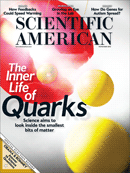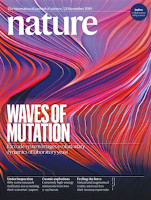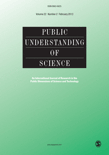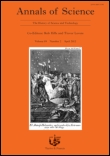
SCIENTIFIC AMERICAN
Scope & Guideline
Advancing Scientific Discourse for All
Introduction
Aims and Scopes
- Interdisciplinary Scientific Communication:
The journal emphasizes the importance of communicating complex scientific ideas in an accessible manner, bridging gaps between scientific communities and the general public. - Focus on Current Scientific Advances:
It regularly covers groundbreaking research and technological progress in fields such as astronomy, biology, environmental science, medicine, and technology. - Public Policy and Science:
Articles often explore the intersections of science with social issues, ethics, and public policy, encouraging informed discourse on pressing global challenges. - Innovative Research Methodologies:
The journal highlights innovative methodologies and technologies that are transforming scientific research, including AI applications, data analysis techniques, and experimental designs. - Environmental Awareness:
There is a consistent emphasis on environmental science, climate change, and sustainability, reflecting the urgent global need for ecological awareness and action.
Trending and Emerging
- Artificial Intelligence and Ethics:
There is a growing focus on the implications of AI in various fields, including healthcare, security, and ethics, reflecting the technology's rapid advancement and societal impact. - Climate Change and Sustainability:
The journal increasingly addresses climate-related issues, emphasizing research on sustainability, renewable energy, and ecological conservation, which are crucial in today's environmental context. - Health Innovations and Public Health:
Emerging themes include advancements in medical technology, public health strategies, and the implications of the COVID-19 pandemic on healthcare systems. - Neuroscience and Mental Health:
Articles exploring the complexities of the brain, mental health disorders, and the intersection of neuroscience with social behavior are on the rise, reflecting growing public interest. - Space Exploration and Astrobiology:
With renewed interest in space exploration, topics related to astrobiology, planetary science, and the search for extraterrestrial life are becoming more prevalent.
Declining or Waning
- Traditional Animal Research:
The journal has moved away from publishing articles focused solely on traditional animal research, reflecting a broader trend towards ethical considerations and alternative research methodologies. - Purely Theoretical Physics:
There appears to be a reduced emphasis on purely theoretical discussions in physics, possibly in favor of more applied science and technology that directly impacts society. - Historical Scientific Narratives:
While historical perspectives remain important, there has been a noticeable shift towards more contemporary issues and forward-looking scientific advancements. - Niche Scientific Topics:
Certain niche topics that once received more attention, such as specific subfields of chemistry or physics, are less frequently covered, possibly due to evolving interests and the journal's broader focus. - General Health Topics:
There is a decline in articles covering general health topics that do not directly relate to current health crises or innovative medical technologies.
Similar Journals

Cultura Cientifica
Empowering Scientific Dialogue, One Article at a Time.Cultura Cientifica is a distinguished open-access journal published by FUNDACION UNIV JUAN CASTELLANOS, dedicated to fostering scientific knowledge and community engagement within the field of science and technology. With an ISSN of 1657-463X and an E-ISSN of 2389-9638, the journal has been providing unrestricted access to research since its inception in 2001, effectively contributing to the dissemination of valuable scientific insights. Based in Tunja, Boyacá, Colombia, "Cultura Cientifica" aims to serve as a platform for researchers, professionals, and students by featuring high-quality research articles, reviews, and case studies that reflect the latest advancements and debates in the scientific community. Although the journal does not currently have an H-index or Scopus ranking, its commitment to open access and knowledge sharing makes it an essential resource for those seeking to expand their understanding and impact within the scientific discourse.

NATURE
Unveiling Innovations Across Diverse DisciplinesNATURE, published by NATURE PORTFOLIO, stands as a premier academic journal in the field of multidisciplinary sciences, and has consistently ranked number one in its category, reflecting its influence and prestige with an impressive 99th percentile position among 171 journals in the Scopus rankings. With an illustrious history dating back to 1869, this journal serves as a critical platform for disseminating pioneering research and groundbreaking discoveries across a myriad of disciplines. While it maintains a traditional publishing model, NATURE's significance is underscored by its high impact factor, making it an essential resource for researchers, professionals, and students seeking to stay at the forefront of scientific advancements. The journal's headquarters are located in Berlin, Germany, and it continues to shape the scientific dialogue globally.

PUBLIC UNDERSTANDING OF SCIENCE
Connecting Knowledge with Public AwarenessPUBLIC UNDERSTANDING OF SCIENCE, published by SAGE PUBLICATIONS LTD, stands as a crucial multidisciplinary journal dedicated to exploring the intricate relationship between science and society. With its well-established history from 1992 through to 2024, this journal offers an essential platform for researchers, professionals, and students interested in the communication of scientific knowledge and its impact on public perception. Recognized for its high academic standards, it proudly holds a Q1 ranking in the categories of Arts and Humanities, Communication, and Developmental and Educational Psychology, signifying its significant influence and contribution to these fields. The journal’s impressive percentile rankings further underscore its vital role in advancing scholarship, interaction, and understanding in the public discourse of science. Although it does not currently offer open access options, the journal is committed to disseminating scholarly research that informs and enriches the dialogue on critical scientific issues, making it a pivotal resource for anyone engaged in or studying the dynamics of science communication.

ANNALS OF SCIENCE
Fostering Scholarly Discourse on Science's LegacyANNALS OF SCIENCE, published by Taylor & Francis Ltd, is a pivotal journal in the field of the History and Philosophy of Science, as evidenced by its Q3 categorization and a respectable Scopus rank of 99 out of 223, placing it in the 55th percentile among its peers. With a rich history dating back to its initial publication in 1936, the journal has made significant contributions to scholarly discourse, providing a platform for researchers and academics to explore the intricate connections between scientific developments and philosophical inquiries. The journal's commitment to rigorous academic research ensures that it remains a vital resource for professionals, educators, and students dedicated to understanding the evolution of scientific thought. Although it operates under traditional subscription models, the journal's importance in shaping modern scientific discussions cannot be overstated, making it an essential read for those engaged in the multifaceted study of science's history and philosophical implications.

Earth System Science Data
Pioneering Open Access for Earth and Planetary ResearchEarth System Science Data, published by COPERNICUS GESELLSCHAFT MBH, is a premier open access journal dedicated to advancing the field of Earth and planetary sciences. With an impressive impact factor, it holds a distinguished Q1 ranking in the Earth and Planetary Sciences category, underscoring its significance within the scientific community. Established in 2009, the journal has been committed to providing a platform for the dissemination of high-quality, freely accessible research data that supports the understanding and management of Earth's complex systems. The journal welcomes contributions that offer extensive datasets, innovative methodologies, and collaborations that push the frontiers of Earth sciences, making it an essential resource for researchers, professionals, and students alike. Based in Göttingen, Germany, Earth System Science Data remains a vital asset for those seeking to engage with and contribute to impactful scientific discourse across the globe.

PHILOSOPHY OF SCIENCE
Unraveling the Threads of Scientific UnderstandingPHILOSOPHY OF SCIENCE, published by Cambridge University Press, serves as a premier journal at the intersection of history, philosophy, and science, making significant contributions to our understanding of scientific inquiry and its historical contexts. With an impressive impact factor reflected in its 2023 Category Quartiles—ranking Q1 in History, Q1 in History and Philosophy of Science, and Q1 in Philosophy—this journal stands out as a vital resource for researchers, professionals, and students alike. Operating without Open Access, it encourages the dissemination of groundbreaking ideas from 1949 through 2024, illustrated by its robust Scopus rankings, including a remarkable 98th percentile in the History category. Based in the United Kingdom at the prestigious Cambridge campus, PHILOSOPHY OF SCIENCE is committed to fostering scholarly dialogue and advancing critical thought in the philosophy of science.

SCIENCE PROGRESS
Connecting researchers through impactful findings.SCIENCE PROGRESS, published by SAGE Publications Ltd, is a prestigious multidisciplinary journal with an impactful presence in the realm of scientific research. Recognized for its high quality, the journal holds a Q1 status in the 2023 category quartiles and ranks 35th out of 171 in its field, placing it in the 79th percentile within Scopus rankings. With its ISSN 0036-8504 and E-ISSN 2047-7163, SCIENCE PROGRESS has been a pivotal platform since its inception in 1946, fostering innovation and dissemination of knowledge across various scientific disciplines. Based in the United Kingdom, the journal aims to provide a comprehensive arena for researchers and professionals to share groundbreaking findings and insights, contributing to the advancement of scientific progress. Although the journal does not offer open access, it continues to be a vital resource for academics and practitioners alike, maintaining its relevance in a rapidly evolving scientific landscape.

Nature Computational Science
Innovating Solutions Through Computational InsightsNature Computational Science, published by Springer Nature, is a leading peer-reviewed journal that plays a pivotal role in advancing the field of computational science. With an impressive impact factor and a strong ranking in Scopus, it holds a prestigious position as Q1 in key categories, including Computer Networks and Communications, Computer Science Applications, and Computer Science (miscellaneous). This journal provides a platform for the dissemination of innovative research that drives the development of computational methods and their application across various scientific domains. Emphasizing open access to foster widespread dissemination and collaboration, Nature Computational Science aims to bridge the gap between theoretical advancements and practical implementations, making it an essential resource for researchers, professionals, and students eager to explore the latest trends and breakthroughs in computational methodologies.

Everymans Science
Fostering Innovation in Every Scientific Field.Everymans Science, with ISSN 0531-495X, is a distinguished journal published by the Indian Science Congress Association. Emphasizing a multidisciplinary approach, this journal aims to bridge the gap between scientific research and public understanding, making it an invaluable resource for researchers, professionals, and students alike. Although not currently an open access publication, it facilitates access to vital findings and insights that contribute to the advancement of science in India and beyond. Highlighting key developments across various scientific fields, including life sciences, physics, and environmental studies, Everymans Science serves as a platform for promoting innovative ideas and fostering collaborative research efforts. Its dedication to excellence in scientific communication ensures that it maintains a prominent place in the academic landscape, making it essential reading for those engaged in scientific inquiry and education.

Momona Ethiopian Journal of Science
Exploring New Frontiers in Scholarly CommunicationMomona Ethiopian Journal of Science is a distinguished open-access journal that has been fostering scholarly communication in the realm of natural and computational sciences since its inception in 2009. Published by the Mekelle University, College of Natural and Computational Sciences, this journal provides a platform for researchers, professionals, and students to disseminate their findings, share innovative ideas, and engage with cutting-edge developments within the field. With its ISSN 2073-073X, the journal aims to enhance scientific discourse by welcoming high-quality manuscripts that address a variety of topics relevant to the Ethiopian and broader scientific communities. Although specific metrics like HIndex and Scopus rankings are currently unavailable, Momona’s commitment to open access ensures that its content is readily accessible, promoting a collaborative atmosphere conducive to research advancement. Located in Mekelle, Ethiopia, this journal not only contributes to local knowledge production but also aligns with global academic trends that emphasize accessibility and interdisciplinary collaboration.